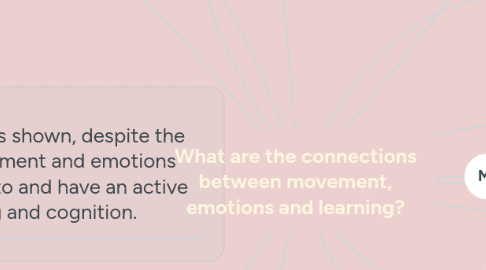
1. Get the class used to role-plays, it could be weekly or daily and about content they have learn.
2. They are highly motivating states that drive hungry organisms toward their goals; in this case, the goal is to feed their hunger by learning more.
3. All motor activity is preceded by quick thought processes that set goals, analyze variables, predict outcomes, and execute movements. This requires widespread connections to all sensory areas.
4. Recent researchs has shown, despite the old belief, that movement and emotions are strongly related to and have an active influence on learning and cognition.
5. Evidence from Imaging Techniques
6. In the past, Science has dismissed the role of emotions in learning. Nowadasys, there is plenty of work that support that emotions are an important variable in the learning process, since mind and emotions are linked.
6.1. Emotions release chemicals that afects many brain areas, and they also activate many areas which are related to memory, decision-making processes, motivation and so on.
6.1.1. Anterior cingulate cortex
6.1.2. Orbitofrontal cortex
6.1.3. Thalamus
6.1.4. Hormonal system
6.1.5. Nucleus accumbens
6.1.6. Amygdala
6.1.7. Hypothalamus
6.2. Fear/threat
6.2.1. Fear usually arises from some sort of threat perception.
6.2.2. The brain has three choices when confronted with overwhelming threat:We can fight, try to escape, or freeze.
6.3. Joy/Pleassure
6.3.1. This state is absolutely essential for all learning.
6.3.2. High levels of dopamine are associated with greater flexibility in the brain’s executive attentional system.
6.4. Sadness/disappointment
6.4.1. This state sounds negative, but we are more likely to remember an experience with a negative bias than one with a positive bias.
6.5. Anticipation/curiosity
6.5.1. Anticipation and curiosity create a positive state of hope and vigilance.
7. Emotions affect students behavior because they create a particular mind-body state. Here are some considerations about them and the influence they have.
7.1. Emotional states are present in everything. Everything we do is state dependent.
7.2. All of our behaviors come from a pool of different choices to pick up, depending on the different states we could have. If I am not in the state for reading, I will not do it. So first, I will have to change that state.
7.3. It is good to know that states are constantly changing. It is unusual to mantain the same state for too long.
7.4. And it is also unuseful and problematic for both the student and the teacher to allowed a state to persist for too long. Because the brain will get used to it and will often seek for it, instead of any other much more positive. Over time, it gets harder to change that state.
8. Suggestions to keep the students body active and to trigger possitive emotional states and engage them in and for learning.
8.1. About emotional states
8.1.1. It is a good idea to ask the students compelling questions to change from one state to another. Maybe from a quite state to an alertness one.
8.1.2. Teachers should show their enthusiasm about teaching and learning, in order to elicit the same response in the students.
8.1.3. Envolve students in debate, dialogue or argument to give their opinion. That will elicit a good deal of emotions. When emotions are engaged after the learning, the information it is more likely to be recall
8.1.4. Ritual in the class can often engaged students. Its good to change it from time to time so the students wont get bored.
8.1.5. Students sharing their stories or reflections about certain things will make them engaged personally. Make connections between their personal lives and what they learn at school.
8.2. About movement activities
8.2.1. Energizer activities like Simon says or team jigzaw puzzles can help with both drowsy and antsy students.
8.2.2. Tell the students to rewrite the lyrics of a song, relating it with content and ask them to play it with a choreography.
8.2.3. Teach them arm and leg crossover activities that can make both brain hemispheres work
8.2.4. Open the class with a stretching time, and make sure to have recesses.
9. Mind and emotions are not separate; emotions, thinking, and learning are all linked.
10. Functional Evidence
10.1. One study showed that people who exercise have far more cortical mass than those who don’t (Anderson, Eckburg, & Relucio, 2002). Simple biology supports an obvious link between movement and learning. Oxygen is essential for brain function, and enhanced blood flow increases the amount of oxygen transported to the brain.
11. Stimulation of certain areas of the brain, through active play, helps stimulate the neural networks that help trigger learning.
11.1. Cerebellum
11.1.1. Information travels to and from the cerebellum, the brain’s center of motor control
